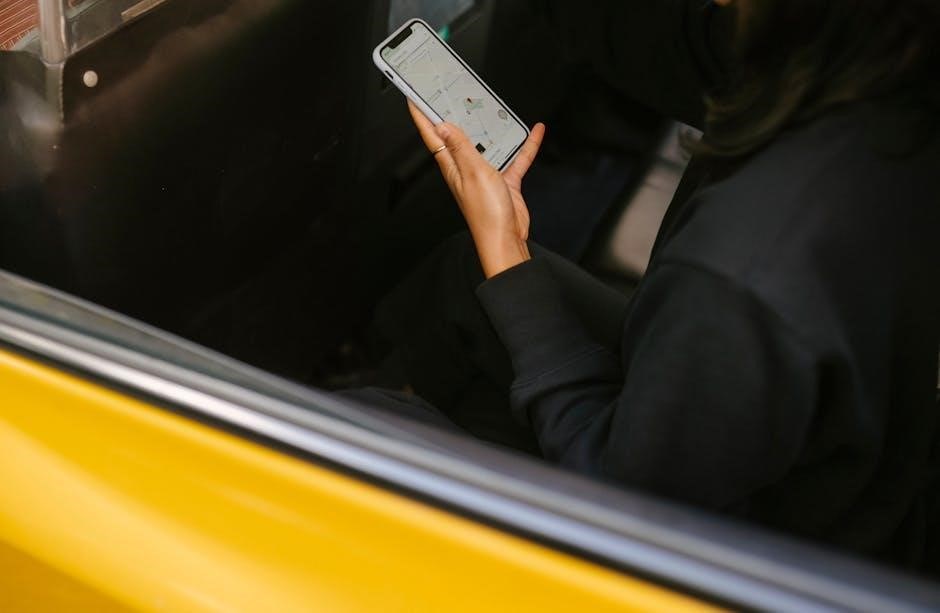Sharpening guide angles are essential for achieving precise edge sharpness in tools and knives․ They ensure consistency and accuracy, helping maintain optimal blade performance․ Understanding these angles is key to mastering sharpening techniques effectively․

Importance of Guide Angles in Sharpening
Guide angles ensure consistency and prevent uneven edges, enhancing blade sharpness and durability․ They help maintain precise control during sharpening, reducing risk of damage and extending tool life while improving safety and efficiency․
Role of Guide Angles in Blade Sharpness
Guide angles play a critical role in achieving optimal blade sharpness by maintaining precise edge geometry․ They ensure the sharpening tool aligns correctly with the blade, allowing for even application of the abrasive․ This consistency prevents uneven edges and promotes a razor-sharp finish․ By maintaining the correct angle, guide angles prevent over-sharpening, which can weaken the blade․ Different guide angles suit various blade types, ensuring the edge is tailored for its intended use․ For example, a more acute angle enhances sharpness for cutting tasks, while a slightly larger angle improves durability for heavy-duty applications․ The precise control offered by guide angles minimizes mistakes, resulting in a sharper, more reliable blade․ Ultimately, guide angles are essential for maximizing edge performance and extending the life of the blade․
Impact of Guide Angles on Edge Durability
Guide angles significantly influence the durability of a blade’s edge by determining the angle at which the edge is sharpened․ A larger guide angle generally results in a more robust edge, as the bevel is wider and less prone to chipping or wear․ This makes the blade more durable for heavy-duty tasks․ Conversely, a smaller guide angle creates a sharper edge, which, while excellent for precision work, may be more susceptible to dulling quickly under stress․ The optimal guide angle balances sharpness and durability, ensuring the blade performs well without compromising its longevity․ Properly set guide angles prevent over-sharpening, which can weaken the edge․ By maintaining the correct angle, users can extend the life of the blade and reduce the frequency of sharpening․ Thus, guide angles are crucial in maintaining both the functionality and longevity of the edge, tailored to the specific demands of the blade’s intended use․

Types of Sharpening Guide Angles
Sharpening guide angles come in various types, including 20-degree, 30-degree, and variable angle guides, each designed for specific tools and tasks to ensure precise edge sharpening and optimal performance․
20-Degree Sharpening Guide Angle
The 20-degree sharpening guide angle is a popular choice for many tools and knives, especially those requiring a sharp, precise edge․ This angle is ideal for blades used in piercing or precision cutting tasks, such as culinary knives or hunting knives․ It provides a balance between sharpness and durability, making it suitable for everyday use․ The 20-degree angle is narrower than the 30-degree option, resulting in a keener edge that excels in tasks requiring fine detail․ However, it may be less durable for heavy-duty applications․ Many sharpening guides and tools offer adjustable settings, allowing users to easily set and maintain the 20-degree angle․ Proper technique is essential to avoid over-sharpening, which can weaken the blade․ With consistent practice, achieving and maintaining this angle ensures optimal performance for a wide range of cutting tools․
30-Degree Sharpening Guide Angle
The 30-degree sharpening guide angle is widely used for tools and knives that require a strong, durable edge․ This angle is ideal for utility knives, survival knives, and other heavy-duty cutting tools, as it provides excellent edge retention and resistance to wear․ The 30-degree angle is broader than the 20-degree option, resulting in a more robust edge that withstands tough cutting tasks․ It is particularly suitable for applications where the blade is subjected to heavy use, such as chopping or cutting through dense materials․ While it may not achieve the same level of sharpness as narrower angles, it offers greater longevity and is less prone to chipping or damage․ Many professionals and DIYers prefer this angle for its balance of performance and durability․ Sharpening guides often include this setting, making it easy to maintain consistency․ Proper technique ensures the edge remains effective and long-lasting, making the 30-degree angle a versatile choice for various sharpening needs․
Variable Angle Sharpening Guides
Variable angle sharpening guides provide unmatched flexibility and customization for sharpening tasks․ These guides allow users to adjust the sharpening angle to suit different types of blades, making them ideal for versatile sharpening needs․ Unlike fixed-angle guides, variable guides enable precise control over the edge angle, ensuring optimal results for various tools and knives; They are particularly useful for sharpening blades with unique geometries or for achieving specific edge characteristics․ The adjustable mechanism typically offers a range of angles, such as 15 to 35 degrees, allowing for fine-tuned sharpening․ Many variable guides feature incremental adjustments, often in 1- or 2-degree increments, ensuring precision․ This adaptability makes them a favorite among professionals and enthusiasts who work with a wide range of blades, from straight-edge razors to hunting knives․ By offering customizable angles, variable sharpening guides enhance the sharpening process, delivering consistent and precise results tailored to the specific needs of the blade being sharpened․

How to Choose the Right Sharpening Angle
Selecting the appropriate sharpening angle is crucial for achieving optimal blade performance․ The angle choice depends on the type of blade, its intended use, and the desired edge durability․ For general-purpose knives, a 20- to 30-degree angle is typically recommended, as it balances sharpness and longevity․ Thinner blades, such as straight razors, often require narrower angles (10-20 degrees) for precision and sharpness, while thicker blades, like axes or chisels, benefit from steeper angles (30-40 degrees) for added durability․ Consider the blade’s material as well; harder steels may require slightly wider angles to prevent chipping․ It’s also important to maintain consistency during the sharpening process to ensure an even edge․ If unsure, start with a moderate angle and adjust based on the blade’s performance․ Always refer to the tool’s specifications or consult a sharpening guide for tailored recommendations․ Proper angle selection ensures a sharper, more durable edge, enhancing the tool’s overall functionality and longevity;

Step-by-Step Guide to Sharpening with a Guide Angle
Position the blade at the desired angle using a guide․ Sharpen with smooth, consistent strokes, maintaining the angle․ Check the edge for sharpness and repeat until desired sharpness is achieved․ Ensure precision for optimal results․
Understanding the Sharpening Tool and Guide
Sharpening tools and guides are designed to help users achieve precise control over blade angles․ A sharpening guide ensures the tool maintains the correct angle during the sharpening process, enhancing accuracy and consistency․ These guides are typically adjustable, allowing users to set specific angles for different blade types․ Sharpening tools, such as water stones, diamond stones, or electric sharpeners, work in conjunction with the guide to remove metal evenly․ The guide acts as a stabilizer, preventing the blade from deviating from the desired angle․ This setup is especially useful for maintaining uniform bevels and achieving a razor-sharp edge․ By understanding how to align the blade and use the guide effectively, users can optimize their sharpening results․ Proper use of the guide minimizes errors, making the sharpening process more efficient and reliable for both beginners and experienced users alike․
Setting the Correct Angle for Sharpening
Setting the correct angle for sharpening is crucial for achieving a sharp, durable edge․ The angle determines how aggressively the blade is sharpened and directly impacts its performance․ Most tools and knives require specific angles, typically ranging between 20° and 30°, depending on their intended use․ For example, finer edges like razors may use narrower angles (around 20°), while heavier tools like axes might require broader angles (closer to 30°)․ To set the angle accurately, use a sharpening guide or protractor to measure and align the blade․ Digital angle guides are also available for precise adjustments․ Once the angle is set, maintain consistent strokes to avoid deviations․ Proper alignment ensures even wear on the blade, leading to a sharper and more durable edge․ Always refer to the tool’s recommended angle specifications for optimal results․ Achieving the correct angle is the foundation of effective sharpening, ensuring both sharpness and longevity of the blade․
Sharpening Process Using a Guide Angle
The sharpening process using a guide angle involves precise steps to ensure a sharp, even edge․ Begin by securing the tool or knife and positioning the sharpening guide at the desired angle․ Lightly draw the blade across the sharpening surface, maintaining consistent pressure and angle alignment․ Repeat strokes on both sides of the edge, alternating as needed to achieve symmetry․ Use a guide with marked angle settings for accuracy, especially for novice sharpeners․ For finer edges, reduce pressure and focus on light, controlled movements․ Inspect the edge periodically to monitor progress and adjust the angle if necessary․ Continue until a sharp, uniform edge is achieved․ Finally, hone the blade using a leather strop or fine-grit stone to polish and refine the edge․ This method ensures a precise, durable finish, making it essential for both everyday tools and professional cutlery․
Honing the Edge to Perfection
Honing the edge to perfection is the final step in achieving a razor-sharp blade․ After sharpening, use a leather strop or fine-grit sharpening stone to refine the edge․ Honing involves light, controlled strokes, maintaining the guide angle to polish the blade․ This step removes micro-scratches and aligns the metal for a smooth, even edge․ Regular honing extends the blade’s durability and ensures optimal performance․ Proper technique is essential to avoid over-polishing, which can dull the edge․ With consistent practice, honing becomes a precise process that enhances both the sharpness and longevity of the blade, making it ideal for professional and everyday use․

Tools for Maintaining the Guide Angle
Manual sharpening guides, electric sharpening tools, and precision angle sharpening devices are essential for maintaining consistent guide angles․ These tools ensure accuracy and control, helping achieve sharp, durable edges on knives and blades effectively․
Manual Sharpening Guides

Manual sharpening guides are indispensable tools for maintaining precise guide angles during the sharpening process․ These devices are designed to hold the blade at a consistent angle, ensuring uniform sharpening across the edge․ Typically made of durable materials like metal or plastic, they are simple to use and require no electricity, making them portable and ideal for both professionals and hobbyists․
- Key Features: Adjustable angle settings, sturdy construction, and easy-to-use designs․
- Advantages: Provide precision control, reduce the risk of uneven edges, and are cost-effective․
- Usage Tips: Always clean the guide before use, ensure the blade is securely positioned, and apply gentle, consistent pressure․
Manual guides are particularly useful for those who prefer traditional sharpening methods or work in environments without access to power sources․ They are also excellent for maintaining the longevity of blades by preventing over-sharpening․
Electric Sharpening Guides
Electric sharpening guides are advanced tools designed to simplify and accelerate the sharpening process․ They utilize automated systems to maintain precise guide angles, ensuring consistent results with minimal effort․ These guides are particularly advantageous for those who value speed and efficiency, as they significantly reduce sharpening time compared to manual methods․
- Key Features: Motorized angle control, adjustable settings for different blade types, and built-in sharpening wheels․
- Advantages: Faster sharpening, ease of use, and the ability to handle both straight and serrated edges with precision․
- Usage Tips: Always follow the manufacturer’s guidelines, start with coarse grit for dull blades, and finish with fine grit for polishing․
Electric guides are ideal for professionals and frequent users who need to maintain multiple tools efficiently․ They often come with preset angles, eliminating the guesswork and ensuring optimal sharpness every time․ Regular maintenance, such as cleaning the wheels and checking alignment, is essential for prolonged performance․
Precision Angle Sharpening Tools
Precision angle sharpening tools are specialized devices designed to maintain exact angles during the sharpening process․ These tools are crucial for achieving consistent results, especially for professionals who require precise control over blade edges․ They often feature adjustable mechanisms, allowing users to set specific angles, such as 20 or 30 degrees, ensuring optimal sharpness tailored to the tool’s intended use․
- Key Features: Adjustable angle settings, calibration options, and durable construction for long-term accuracy․
- Advantages: Enhanced precision, improved edge retention, and suitability for high-performance applications․
These tools are ideal for professionals, such as chefs and craftsmen, who demand consistent sharpness․ Regular calibration and maintenance, such as cleaning and aligning the guide, are essential to ensure continued accuracy․ Precision angle sharpening tools are a vital investment for anyone seeking reliable and repeatable results in their sharpening process․

Maintenance and Care of Sharpening Tools
Proper maintenance and care of sharpening tools are essential to ensure their longevity and effectiveness․ Regular cleaning prevents the buildup of metal particles and debris, which can interfere with the sharpening process․ For manual sharpening guides, a soft cloth and mild detergent are sufficient, while electric sharpening tools may require specific cleaning solutions․ Storage in a dry, protected environment helps prevent rust and damage․ Lubricating moving parts, such as hinges or adjustment mechanisms, ensures smooth operation and prevents wear․ Inspecting tools for signs of wear, such as dull surfaces or misalignment, and addressing these issues promptly maintains accuracy․ Proper care not only extends the life of sharpening tools but also ensures consistent results․ Regular maintenance routines, tailored to the type of tool, are crucial for optimal performance and reliability in sharpening tasks․

Common Mistakes When Using a Sharpening Guide
When using a sharpening guide, several common mistakes can hinder the sharpening process․ One of the most frequent errors is applying too much pressure, which can damage the blade or misalign the guide․ Another mistake is failing to check the angle before sharpening, leading to inconsistent results․ Many users also overlook the importance of honing after sharpening, leaving the edge rough․ Additionally, using the wrong type of sharpening stone or tool for the specific blade material can reduce effectiveness․ Improper storage of the sharpening guide, such as exposing it to moisture or dirt, can also affect its accuracy over time․ Finally, neglecting to clean the guide after use allows metal particles to accumulate, potentially damaging the tool․ Avoiding these mistakes ensures better outcomes and extends the life of both the guide and the blades being sharpened․

Safety Precautions While Sharpening
Sharpening tools and blades requires careful attention to safety to avoid accidents․ Always wear protective gear, such as gloves and safety glasses, to shield hands and eyes from sharp edges and flying particles․ Ensure the work area is well-lit and free from clutter to maintain clear visibility and prevent tripping hazards․ Secure the blade or tool firmly in a vice or sharpening guide to avoid slips․ Never sharpen near children or pets, as distractions can lead to injuries․ Keep fingers away from the cutting edge and avoid touching the blade excessively, as it may cause cuts․ Use a sharpening stone or tool specifically designed for the blade type to minimize risks․ After sharpening, carefully dispose of metal shavings and clean the workspace to prevent accidents․ Always follow the manufacturer’s guidelines for sharpening tools and maintain a steady, controlled motion throughout the process․ Neglecting safety precautions can result in serious harm, so stay alert and focused during the sharpening process․

Leave a Reply
You must be logged in to post a comment.